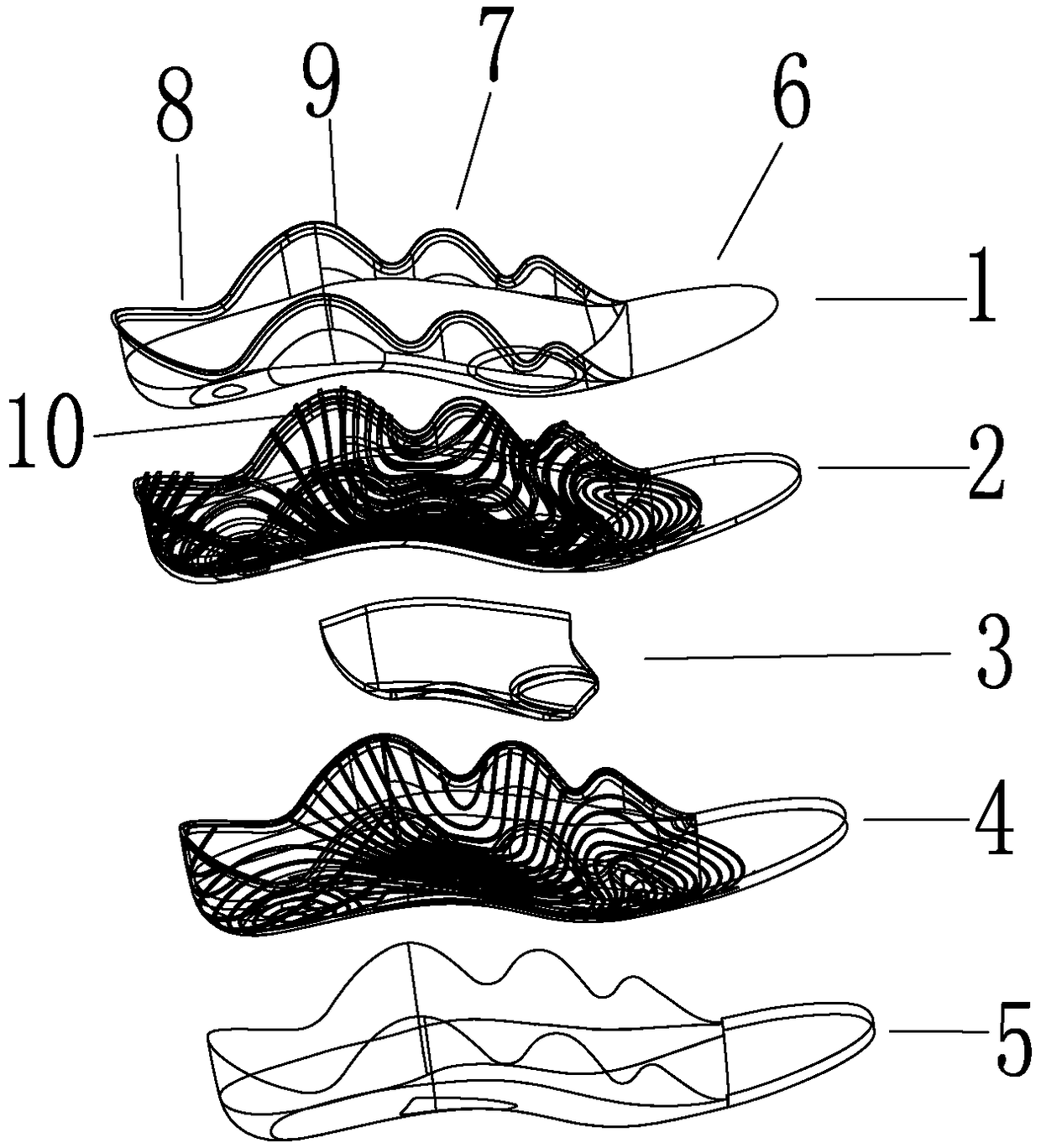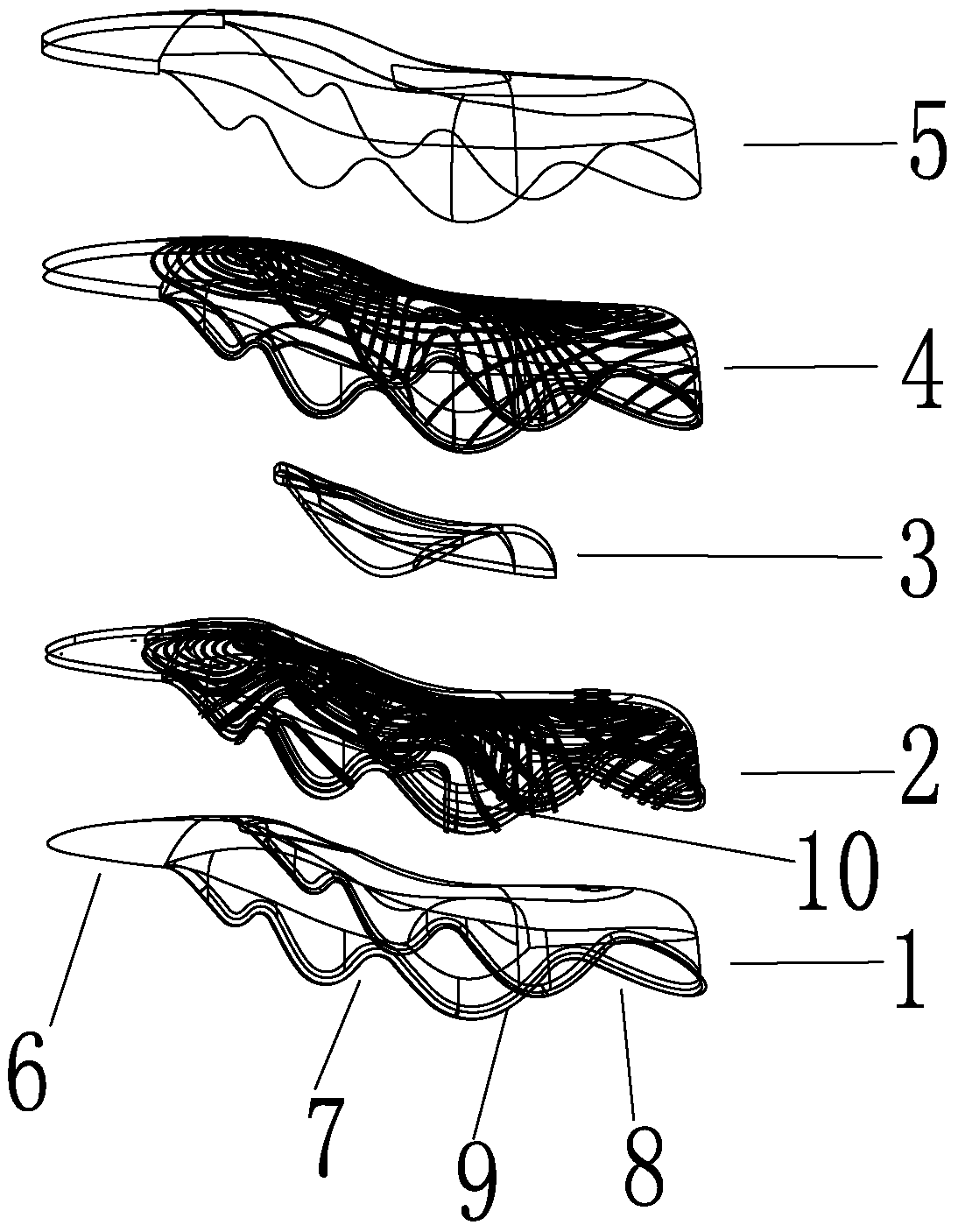Sock-insole two-in-one insole
A two-in-one, insole technology, applied in the field of insoles, can solve the problems of small differences in hardness and achieve moderate hardness, improved comfort, and good elasticity
- Summary
- Abstract
- Description
- Claims
- Application Information
AI Technical Summary
Problems solved by technology
Method used
Image
Examples
Embodiment 1
[0028] Prepare the first nanometer bamboo charcoal fiber layer 1 and the second nanometer bamboo charcoal fiber layer 5:
[0029] Weigh the following components by weight: 6 parts of corn fiber, 70 parts of nano-bamboo charcoal fiber, 0.5 part of polypropylene fiber, 1.5 parts of nylon cotton, 1.3 parts of tocopherol, 3-heptyl-2-heptylthio-4-methyl 0.2 parts of thiazol-3-ium iodide salt, 0.8 parts of chitin, 0.9 parts of poria cocos, 0.45 parts of safflower, 0.8 parts of aloe, 0.7 parts of benzethonium chloride, and 1.5 parts of 1,2-propylene glycol. The first nanometer bamboo charcoal fiber layer 1 and the second nanometer bamboo charcoal fiber layer 5 are obtained by spinning.
[0030] Other structural components of the insole are obtained from existing materials through common methods.
Embodiment 2
[0032] Prepare the first nanometer bamboo charcoal fiber layer 1 and the second nanometer bamboo charcoal fiber layer 5:
[0033] Weigh the following components by weight:
[0034] 9 parts of corn fiber, 85 parts of nano-bamboo charcoal fiber, 4 parts of polypropylene fiber, 3.5 parts of nylon cotton, 2.8 parts of tocopherol, 3-heptyl-2-heptylthio-4-methylthiazol-3-ium iodide salt 0.45 parts, chitin 1.5 parts, Poria 1.0 parts, safflower 0.55 parts, aloe vera 1.1 parts, benzethonium chloride 1.3 parts, 1,2-propanediol 4.5 parts. The first nanometer bamboo charcoal fiber layer 1 and the second nanometer bamboo charcoal fiber layer 5 are obtained by spinning.
[0035] Other structural components of the insole are obtained from existing materials through common methods.
Embodiment 3
[0037] Prepare the first polyurethane foam layer 2 and the second polyurethane foam layer 4:
[0038] The raw materials for the preparation of the first polyurethane foam layer 2 are: 40 parts of isophorone diisocyanate; 40 parts of diphenylmethane diisocyanate; 10 parts of polyether polyol; 0.5 part of phosphoric acid; 0.5 part of N,N-dimethylcyclohexylamine; 0.5 part of crosslinking agent; 3 parts of cooling agent; 4 parts of foaming agent; 0.2 part of stabilizer; share;
[0039] The cooling agent is prepared from L-menthol and N,2,3-trimethyl-2-isopropylbutanamide at a weight ratio of 2-5:1; the foaming agent is n-heptane; The cross-linking agent is a mixture of ethylenediamine, triethylene glycol and dipropylene glycol; the stabilizer is cyclodextrin, methylcellulose, pectin, gelatin hydrolyzate, carrageenan, gellan gum, red A mixture made of alginate, alginic acid, enzymatically decomposed lecithin, casein, xanthan gum and other components; the antibacterial agent is po...
PUM
| Property | Measurement | Unit |
|---|---|---|
| Hydroxyl value | aaaaa | aaaaa |
Abstract
Description
Claims
Application Information
 Login to View More
Login to View More - R&D
- Intellectual Property
- Life Sciences
- Materials
- Tech Scout
- Unparalleled Data Quality
- Higher Quality Content
- 60% Fewer Hallucinations
Browse by: Latest US Patents, China's latest patents, Technical Efficacy Thesaurus, Application Domain, Technology Topic, Popular Technical Reports.
© 2025 PatSnap. All rights reserved.Legal|Privacy policy|Modern Slavery Act Transparency Statement|Sitemap|About US| Contact US: help@patsnap.com


